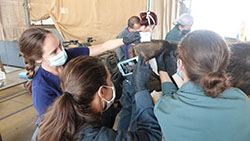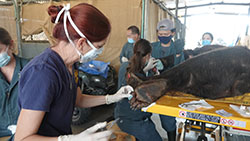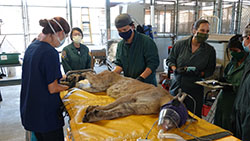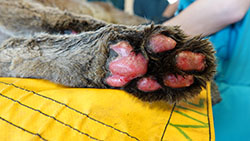The burned paw pad of a bear found in the wake of the Bear (North Complex).

Wildlife veterinarians document the bear’s injuries prior to treatment.

Burn treatment protocol includes the use of sterilized fish skins as a natural bandage for damaged tissue.

Wildlife veterinarians assess a mountain lion that was burned in the Bobcat Fire.

The burned paw pad of a mountain lion found in the wake of the Bobcat Fire.
In early December 2017, wildlife veterinarians from the UC Davis School of Veterinary Medicine and CDFW teamed up to try to save the life of a black bear that sustained third-degree burns in Southern California’s Thomas Fire. The innovative treatment involved the use of tilapia skins as natural bandages for the bear’s paw pads while she recovered from her injuries at CDFW’s Wildlife Investigations Laboratory (WIL) in Rancho Cordova.
Before the month was out, two more victims of the Thomas Fire joined her – a second burned bear, and a young mountain lion. The fish skin treatments were successful and all three patients survived – the bears were released back to the wild, and the orphaned lion cub, which was deemed too young to survive on its own, was placed in a sanctuary. In August 2018, the Carr Fire near Redding sent a fourth burned ursine patient to the lab, which was again treated and successfully released.
The veterinary science was groundbreaking, and the opportunity so very exciting for the team involved, especially the project’s leads, UC Davis’s Dr. Jamie Peyton and CDFW’s Dr. Deana Clifford.
Unfortunately, these four cases were just the beginning, with additional wild animals being burned in the Carr and Camp fires. The 2020 fire season in California has been even more severe, with more than 7,700 individual fires consuming 3.7 million acres of wildlife habitat so far. On Sept. 11, the WIL received its first burn patient of 2020, a 370-lb. male black bear from the aptly named Bear Fire (which later became the North Complex Fire) in Butte County. On Sept. 21, the second patient, a female mountain lion from the Bobcat Fire in Los Angeles County, arrived. On Sept. 30, a 520-lb. male bear was brought in from the Zogg Fire in Shasta County.
“Both bears and the lion are receiving our burn protocol, including the fish skin bandages, and we are optimistic that their burns will heal so that they can be released,” Dr. Clifford said. “But it’s likely that we will receive more wildlife with burns … we are only halfway through the regular fire season.”
As California’s wildfires grow in intensity, size and frequency, our state’s wildlife veterinarians are being forced to reexamine the big picture -- how wildlife are faring, to what extent we should intervene and what our capacity is to do so.
“While we know what a devastating effect wildfires have on our human population – and, to a lesser degree, domestic animals – our knowledge about how wildfires affect wildlife (non-domestic animals) during and immediately after the disaster has been so limited,” Dr. Peyton said. “There’s always been this prevailing mindset that ‘they’ll get out of the way,’ or that they can manage if left alone, but that needs to change. With the increase in frequency and severity of disasters, wildlife cannot escape. Without human interference, these animals will suffer and succumb, due not only to their injuries but also to the loss of food, water and habitat. It is our obligation to provide the missing link for the wildlife that share our home.”
A successful response to this developing need will require resources – time, money, and professional expertise. In an effort to build these resources quickly and efficiently, CDFW and the UC Davis School of Veterinary Medicine have drawn up a proposal for a wildlife search and rescue, field triage, transport and long term rehabilitation care system for injured wildlife resulting from wildfires.
The Wildlife Disaster Network, as it’s been dubbed, is modeled after the Oiled Wildlife Care Network (OWCN) – a similar structure created in 1994 to mobilize volunteers and professionals to help save shorebirds and other wildlife that are injured during coastal and inland oil spills.
The new Wildlife Disaster Network will include veterinarians, wildlife biologists, ecologists, trained animal care volunteers and rehabilitation centers that follow the four core principles already set by the OWCN: readiness, response, research and reaching out. There will also be field reconnaissance in the aftermath of fires, conducted by UC Davis-affiliated staff, with the approval and oversight of Incident Command, when conditions are deemed safe to do so. In addition, they have established a hotline for first responders, utility workers, and the general public to call in for assistance with coordinating care for injured wildlife: 1 (800) 942-6459 (1-800 WHC-OIL-9).
“The idea is to create a collaborative process – which works within any existing emergency incident command structure – that brings experts together to respond to injured animals and prevent suffering,” Dr. Clifford said.
In addition to easing the suffering of animals that are trapped by wildfires in California’s changing climate, the vets hope that the Wildlife Disaster Network will allow for California’s wildlife veterinarians and disaster response professionals to add to their knowledge, and promote further collaboration with others to share this knowledge. The long-term impacts on wildlife from these massive disasters are also largely unknown and in critical need of further investigation and intervention, especially in areas with threatened species. All of the data collected by the participants of the Wildlife Disaster Network – such as necropsy reports on the animals who do not survive their injuries – will help build a framework of scientific knowledge that didn’t previously exist.
Initially, equipment used in this effort will be loaned on an as-needed basis by the OWCN and CDFW. Ongoing financial support for this effort will be through fundraising from private donors via a gift fund to be established by UC Davis.
“These animals in need of care are a visible, tangible and poignant reminder that climate-changed induced wildfires are impacting our wildlife and ecosystems,” said Dr. Clifford. “They remind us that each of us should continue efforts to reduce the impacts of climate change.”
Donations to the Wildlife Disaster Network can be given online at the  California Wildlife Conservation General Support website or by calling the UC Davis School of Veterinary Medicine, Office of Advancement, at (530) 752-7024.
California Wildlife Conservation General Support website or by calling the UC Davis School of Veterinary Medicine, Office of Advancement, at (530) 752-7024.
###
Media Contact:
Kirsten Macintyre, CDFW Communications, (916) 804-1714
CDFW photos